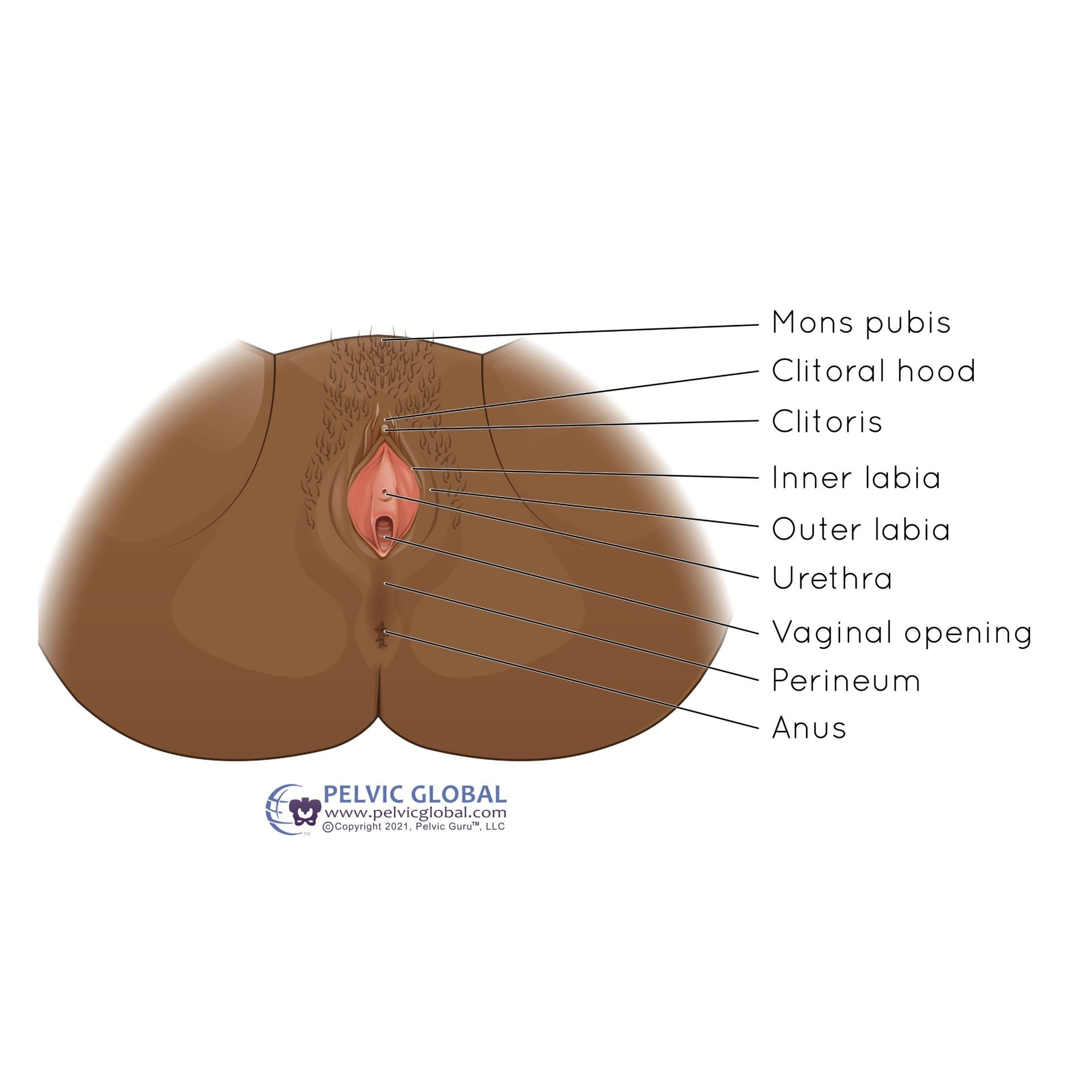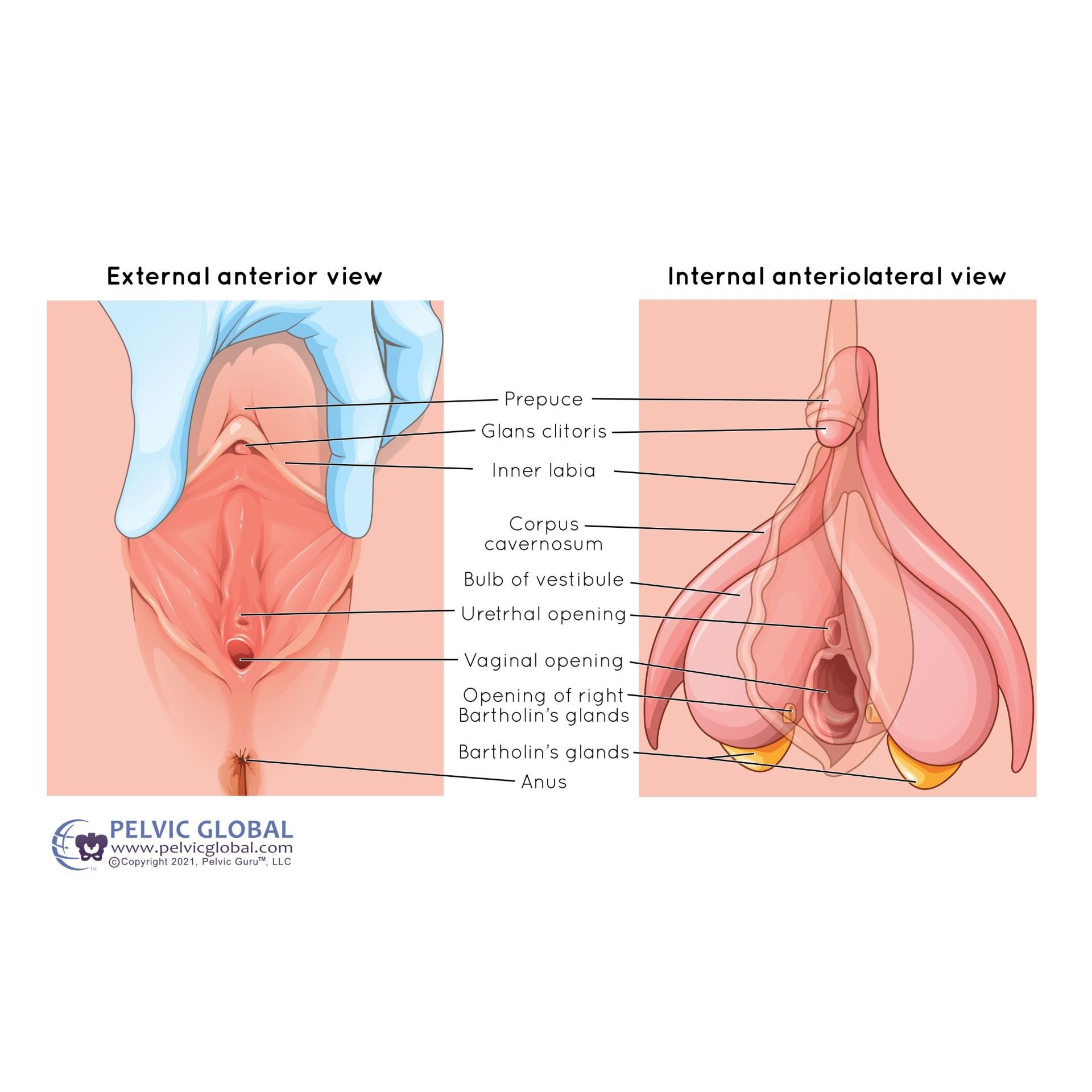Empower Yourself with Knowledge:
What you need to know about the Female Anatomy
Have you encountered videos where individuals ask men about the female anatomy, and they respond with confusion or incorrect answers? While this may be surprising, what is even more surprising is that many women are not fully aware of their own anatomy.
Let’s return to the basics!
The external structures:
Perineum:
This refers to everything that is in between your pubic bone to your coccyx bone. Not only does this area include the pelvic floor muscles but also the reproductive, bowel and bladder systems. It is the area you can see “down there”.
Vulvar vs. Vagina:
We have all discussed our vaginas, but many of us may not be using the term correctly. The vulva refers to the external part of the genitals, including the mons pubis, clitoral hood, clitoris, labia majora and minora, urethra sphincter, vaginal opening, perineum and anus.
Image used with permission from Pelvic Guru®, LLC www.pelvicglobal.com
The vagina, on the other hand, refers to the internal part of our genitals, and it is the opening where penetration, pelvic exams and/or tampons are placed.
Clitoris:
The clitoris is situated at the opening of the vulva, above the urethra and vaginal opening. It is positioned inside the labia with a hood covering it. This area contains numerous nerve endings, more than any other part of the female body. The job of the clitrois is for pure pleasure. Despite appearing pea-sized externally, the clitoris is much larger as it extends inside our bodies.
Image used with permission from Pelvic Guru®, LLC www.pelvicglobal.com
Urethral Sphincter:
The urethra is located between the vaginal opening and clitoris. The function of the urethra is where the urine comes out.
Vaginal opening (the introitus):
Situated beneath the urethra sphincter, this is the region where you can insert a tampon, undergo a pelvic exam, or experience penetration with a penis, dilator, and/or sex toy.
Moving into the internal structures:
The Pelvic Organs:
Bladder:
Situated behind and slightly above the pubic, extending into your lower abdomen, its function is to store urine prior to voiding. Dysfunction can occur, including bladder infection to the bladder, prolapse, and leakage. This can lead to difficulties in emptying, pain during urination and/or uncontrollable and unaware leaking.
Rectum:
Situated along the coccyx and sacrum bone, its function is to store stool prior to passing bowel movements. When dysfunction can occur fissures and hemorrhoids can appear causing pain and difficulty emptying bowel movement.
Uterus:
This organ is part of the female reproductive system, situated above the vaginal canal. It is often referred to as the “womb” due to its function of carrying the baby during pregnancy.
Ovaries and Fallopian Tubes:
Ovaries, situated on the right and left of the lower abdomen, play a vital role in releasing eggs for pregnancy and menstruation. Fun fact: you are born with all of the eggs that you will have for your lifetime. During menopause, the ovaries stop releasing the eggs.
Fallopian tubes carry the eggs to the uterus and can play a crucial part in fertilization contributing to the female reproductive system.
Image used with permission from Pelvic Guru®, LLC www.pelvicglobal.com
Last but not least - The pelvic floor muscles (in my opinion, the most important internal structure!)
The pelvic floor muscles consist of three different layers(superficial, middle and deep layers). These muscles are commonly referred to as “Kegel” muscles, but you may also hear them mentioned in terms of pelvic floor contractions or pelvic floor exercises- essentially denoting the same muscles. This area is crucial for controlling urine and bowel movements and plays a role in sexual functions. Below is your cheat sheet for the role of the pelvic floor muscles: The 5 S’s
Supportive:
These muscles offer support to the pelvic organs, including the bladder, uterus and bowel.
Stability:
The pelvic floor muscles coordinate with the abdominals, back and diaphragm to ensure stability throughout the trunk
Sphincteric:
They assist in bowel and bladder control by closing the sphincters that regulate urine flow and holding back gas
Sexual:
These muscle play a role in achieving orgasms
Sump Pump:
They contribute to the lymphatic system, and ading in circulating fluids around the pelvis.
Image used with permission from Pelvic Guru®, LLC www.pelvicglobal.com
Now that you are familiar with your female anatomy, pass this information along to your mom, sister, aunt, niece, cousin or daughter. Let’s strive to make this standard education for understanding our anatomy.
If you are wondering how pelvic floor physical therapy can help you, check out my other blog on “What exactly is Pelvic Floor Physical Therapy?”
Dr. Susan Miller PT, DPT, is a licensed pelvic floor physical therapist and the owner of Lotus Core Physical Therapy in Colorado. She welcomes both in-person and telehealth appointments for Colorado residents, as well as coaching calls for clients residing out of state.
Book at www.lotuscorept.com








